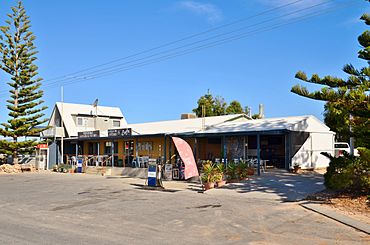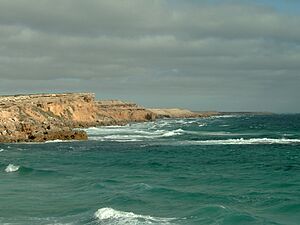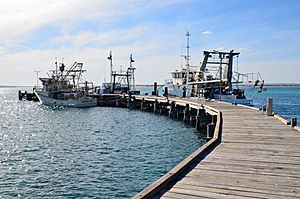Venus Bay, South Australia facts for kids
Quick facts for kids Venus BaySouth Australia |
|
|---|---|

Venus Bay General Store
|
|
| Established | 1864 |
| Postcode(s) | 5607 |
| Elevation | 1 m (3 ft) |
| Location | 665 km (413 mi) North West of Adelaide |
| LGA(s) | District Council of Elliston |
| State electorate(s) | Flinders |
| Federal Division(s) | Grey |
Venus Bay is a small town on the Eyre Peninsula in South Australia. It's a popular spot for tourists and fishing. The town sits right on a beautiful bay with the same name.
Most of the year, only a few dozen people live here. But during the summer holidays, many more visitors arrive. People come to enjoy the calm waters and great fishing. Professional fishermen also use Venus Bay as a base for their work.
Contents
A Look Back in Time
Captain Matthew Flinders first saw the coast near Venus Bay in 1802. He was mapping the southern coast of Australia. However, he didn't land or give the bay a name.
The first Europeans to explore the bay were from a ship called the Nerus in 1839. They were looking for good places to set up new settlements. But they didn't name the bay either.
Sheep farmers soon came to the area. In 1850, a schooner (a type of sailing ship) named Venus entered the bay. It was there to pick up wool. The bay was named "Venus Bay" after this ship. The Venus ship carried wool, wheat, and people along the coast.
A whaling station was built in the 1850s. This helped the town grow. For about 20 years, Venus Bay was just a shop, a hotel, and a police station. In 1855, some Aboriginal police officers were stationed here.
Later, farming became more important than wool. Farmers started growing cereal crops in the 1870s. The town was officially planned in 1864. It was first called "Parkin" after a famous businessman named William Parkin. But in 1940, its name was changed back to "Venus Bay."
By 1900, the town was almost empty. But in the 1920s, it came back to life. This happened when it became a base for commercial fishing. A school even opened in 1939, but it closed in 1955.
Nature's Beauty
Venus Bay is known for its unique natural environment. The bay has many tidal flats, shallow lagoons, and mangroves. There are also islands and deep channels that connect to the ocean.
Tall cliffs line the entrance to the bay. But inside the bay, the land is flat. Much of this flat land is used for agricultural farming. The bay itself is very calm and protected. Outside the entrance, large ocean waves crash against the coast.
Important Bird Area
Venus Bay is a special place for birds. It has wetlands and beaches that are home to many different species. BirdLife International has named it an "Important Bird Area."
This means it regularly supports many pied and sooty oystercatchers. It also has smaller numbers of fairy terns. These birds love the bay's sheltered waters and rich food sources.
How People Live Here
The town's economy depends a lot on commercial fishing. Many boats use Venus Bay to unload their catches. They bring in fish, lobster, and abalone to sell. Farming also helps the local economy. However, most farms are closer to Port Kenny.
Fun for Visitors
Venus Bay also relies heavily on tourism. Many people visit, especially in the summer. The small caravan park often gets full during these busy times.
It's a great place for fishing and water sports. The calm waters are perfect for small boats. You can catch many types of fish here. These include whiting, salmon, garfish, and even gummy shark. Most of these can be caught right off the town's jetty.
There are also walking trails near the town. You can take drives to nearby places like Talia Caves and Mount Camel Beach. The local general store and cafe offer daily supplies and places to stay. You can also find accommodation at the caravan park or in private beach houses. The northern part of the Lake Newland Conservation Park is about 20 kilometers south of the town.




